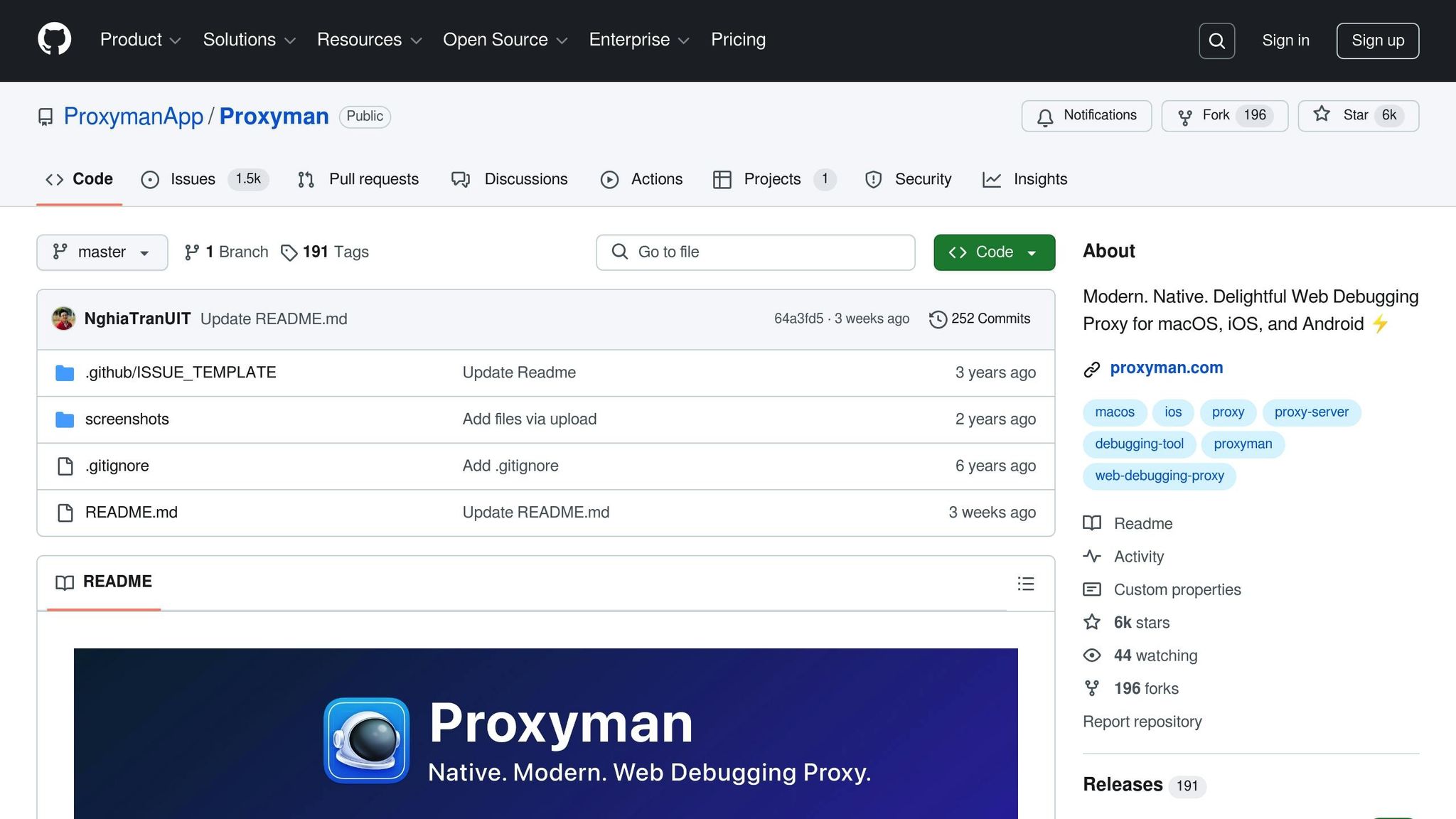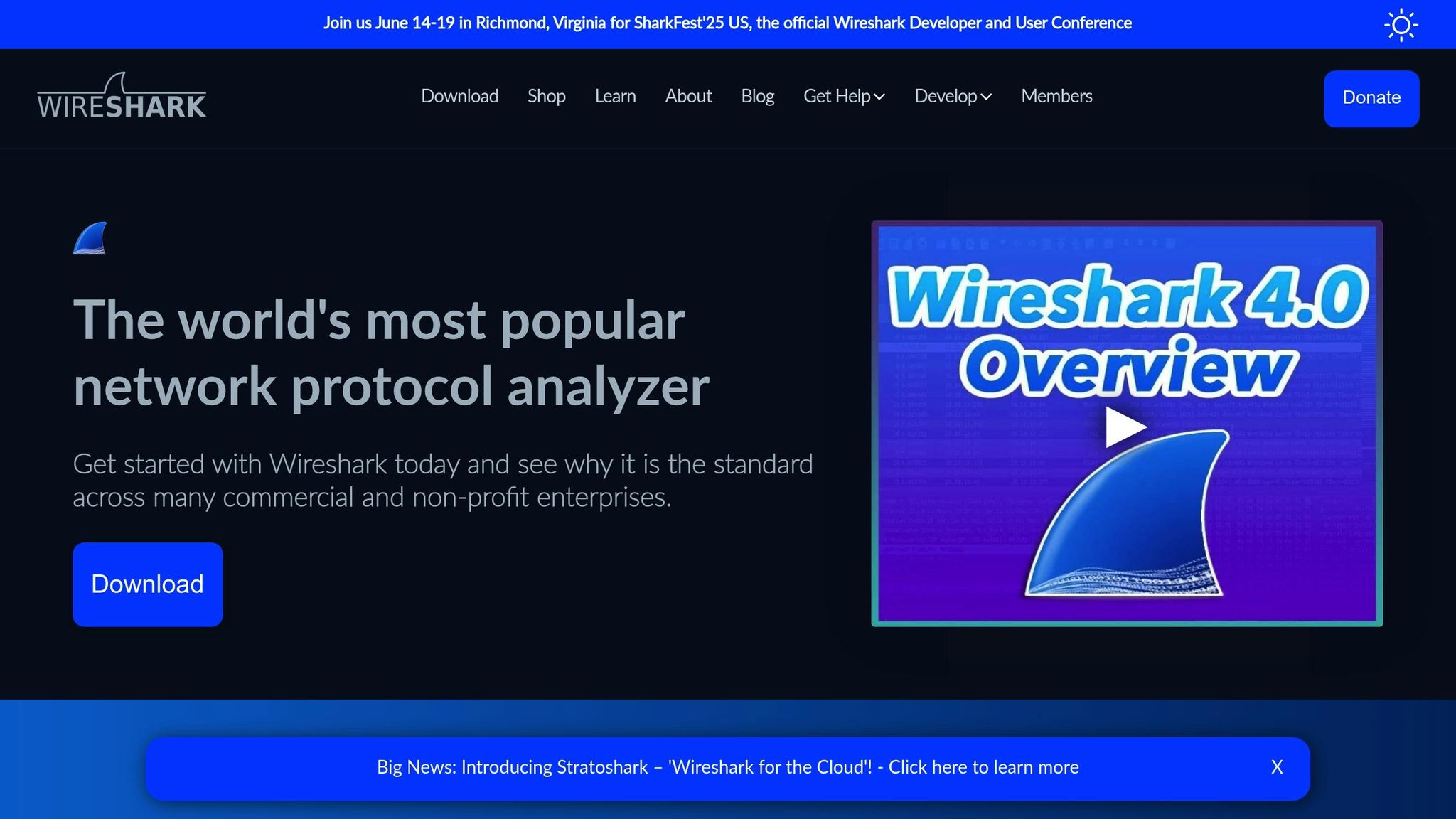
Ultimate Guide to HTTPS Traffic Analysis on Mac
Analyzing HTTPS traffic on your Mac is essential for debugging APIs, testing authentication flows, and identifying network issues. This guide simplifies the process with tools, techniques, and tips to get you started.
-
Why Analyze HTTPS Traffic?
- Debug API requests and responses.
- Test SSL/TLS certificates and security setups.
- Troubleshoot performance and authentication issues.
-
Key Tools for macOS:
- ReqRes: One-click HTTPS monitoring and API testing.
- Charles Proxy: Advanced debugging with SSL proxying.
- Proxyman: Modern interface, optimized for macOS.
- Wireshark: Deep network packet analysis.
-
Setup Requirements:
- macOS 10.15 or newer.
- Admin privileges for SSL certificate installation.
- Familiarity with command-line tools and network protocols.
- Quick Comparison of Tools:
| Tool | Features | Best For |
|---|---|---|
| ReqRes | Easy setup, live monitoring | Quick HTTPS debugging |
| Charles Proxy | SSL proxying, request modification | Advanced API analysis |
| Proxyman | Optimized for macOS, scripting | Modern debugging workflows |
| Wireshark | Packet-level inspection | Deep network analysis |
With the right tools and setup, you can securely and efficiently analyze HTTPS traffic to improve your development workflow.
Mac Setup Requirements
Set up your Mac to configure system settings and install SSL certificates for analyzing and decrypting HTTPS traffic.
Required Knowledge and Tools
Here's what you'll need:
| Component | Requirement | Purpose |
|---|---|---|
| macOS Version | 10.15 (Catalina) or newer | Ensures compatibility with modern SSL/TLS protocols |
| System Access | Administrator privileges | Required for certificate installation and system adjustments |
| Development Tools | Command line experience | Necessary for managing certificates and configuring tools |
You should also be comfortable with TCP/IP, HTTP/HTTPS, SSL/TLS, command line operations, and proxy settings. Once you're ready, you can move on to configuring your SSL certificates.
Certificate Setup Guide
Follow these steps to set up SSL certificates for HTTPS traffic analysis:
-
Generate Root Certificate
Create a root certificate that complies with Apple's security standards. If you're using macOS 14 or later and encounter OpenSSL v3 issues, use the–legacyflag during certificate generation. -
Configure Certificate Parameters
Make sure your root certificate includes:- An RSA key size of at least 2048 bits
- The SHA-256 hash algorithm
- The server's DNS name in the Subject Alternative Name (SAN) field
-
Install in Keychain
Add your certificate to macOS Keychain by following these steps:- Open Keychain Access
- Import the certificate file (accepted formats: PEM, DER, or PKCS #12)
- Set the certificate to "Always Trust" for SSL/TLS connections
For extra security, store custom certificate passphrases in the Keychain. If you run into SSL handshake errors, check the trust settings in both the Login and System keychains. To prevent conflicts with production certificates, you might want to create a separate certificate profile for development use.
Mac HTTPS Analysis Tools
Check out the best tools for HTTPS analysis on macOS. From the native ReqRes app to other powerful options, these tools help with real-time monitoring and precise debugging.
ReqRes for macOS
ReqRes is a native macOS app designed for live HTTPS monitoring, local API response testing, and simple traffic interception. Here's a quick breakdown of its key features:
| Feature | Description |
|---|---|
| Real-time Monitoring | Inspect HTTP(S) requests and responses as they happen |
| Local Mocking | Use local files as API responses for testing |
| Traffic Interception | Set up HTTPS traffic inspection with just one click |
| Response Debugging | Analyze and modify responses using built-in tools |
While ReqRes is great for macOS users, other tools provide cross-platform compatibility and additional features.
Using Charles Proxy
To get started with Charles Proxy, install it and navigate to Help > SSL Proxying > Install Charles Root Certificate. Then, open Keychain Access, double-click the certificate, and set it to "Always Trust."
Charles Proxy is a versatile debugging tool that can handle tasks like:
- Verifying analytics tracking beacons
- Modifying HTTP requests
- Simulating slower network connections
- Acting as a proxy for iOS and Android devices
Working with Proxyman

After setting up Charles Proxy, you might want to try Proxyman. It’s optimized for performance and works seamlessly on Apple Silicon. Built with SwiftNIO, Proxyman offers a modern, macOS-native experience.
"Officially switching to @proxyman_app after 10 years of using Charles! Much better interface, app performance, and also shows what process is making a particular web request!" - Ananay
Proxyman adds even more to your HTTPS debugging toolkit with features like:
- Debugging GraphQL queries
- Advanced filtering options
- JavaScript-based scripting for requests and responses
- Breakpoint debugging for precise control
Wireshark Setup

If you're looking for deep network analysis, Wireshark is a powerful option. It captures TCP/UDP packets and provides detailed protocol insights, though it requires more technical expertise.
| Aspect | Details |
|---|---|
| Analysis Level | Inspects TCP/UDP packets |
| Target Users | Security developers and network analysts |
| Key Capability | Detailed network protocol analysis |
| Learning Curve | More challenging than proxy-based tools |
"If you are a hacker/security developer who needs a full-set proxy tool to dig deep into the network level, Wireshark might be your go-to option."
For most developers, proxy-based tools like ReqRes are easier to use for HTTPS traffic analysis. Wireshark, on the other hand, is ideal for advanced network debugging.
HTTPS Analysis Methods
Learn how to handle HTTPS analysis by focusing on techniques for capturing, decrypting, and testing API traffic.
Capturing HTTPS Traffic
Here's a quick comparison of how two popular tools, ReqRes and Charles Proxy, handle traffic capture:
| Setup Step | ReqRes | Charles Proxy |
|---|---|---|
| Initial Config | One-click setup | Enable macOS Proxy |
| Certificate | Auto-installed | Manual installation needed |
| Traffic Types | HTTP/HTTPS | TCP/UDP/HTTP/HTTPS |
| Device Support | macOS native | iOS/Android/Simulators |
If you're using Charles Proxy, make sure to enable SSL Proxying in the settings. Double-check that your target host is listed under SSL Proxying Settings. Once traffic is captured, move on to decrypting it for deeper insights.
HTTPS Traffic Decryption
To decrypt HTTPS traffic, follow these essential steps:
- Certificate Installation: Install the tool's root certificate as instructed to enable decryption.
- iOS Simulator Setup: Use the tool’s help menu to install the root certificate on iOS Simulators.
- Mobile Device Configuration: Install the root certificate on both iOS Simulators and physical devices. Tools like Proxyman simplify this process with automatic setup options for iOS and Android.
Once decrypted, you can analyze, verify, or modify API traffic as needed.
API Testing and Mocking
API testing tools come with features that simplify debugging and quality checks. Here's a breakdown:
| Testing Feature | Capability | Use Case |
|---|---|---|
| Response Mocking | Map responses to local files | Offline development |
| Request Modification | Edit headers and parameters | Debugging APIs |
| Traffic Recording | Save and replay sessions | Regression testing |
| Protocol Validation | Ensure HTTP compliance | Quality assurance |
These features allow you to test and refine API behavior while ensuring compliance and functionality.
Security and Performance Tips – Securing and Optimizing Your HTTPS Analysis
Once your tools are set up, it's important to secure your environment and improve performance. Here are some practical strategies to help you achieve both.
Data Security Guidelines
Handling HTTPS data securely is crucial for maintaining both performance and isolation during analysis. Consider these key measures:
| Security Measure | Implementation | Purpose |
|---|---|---|
| Certificate Management | Install only essential root certificates | Prevent unauthorized HTTPS decryption |
| Traffic Filtering | Enable SSL Proxying only for specific hosts | Reduce exposure of sensitive data |
Always double-check that SSL Proxying is active only for the intended hosts. This ensures data security during debugging.
Performance Optimization
To keep things running smoothly, enable SSL Proxying only for the domains you're analyzing. This approach minimizes unnecessary overhead and keeps performance intact.
Safe Testing Environment
Keep testing and production systems separate to avoid unintended impacts. Here’s how you can create a secure and controlled testing environment:
-
Environment Isolation
Use separate network profiles for testing and production traffic. This ensures that your analysis won't interfere with live systems. -
Tool Configuration
Set up your tools with a trusted SSL certificate and enable SSL Proxying for all necessary domains. This setup ensures accurate analysis while maintaining security. -
Monitoring Setup
Use monitoring tools to keep an eye on your isolated environment. Here's a quick guide:Monitoring Aspect Tool Purpose Network Requests Browser DevTools Inspect web traffic System Traffic tcpdump/Wireshark Perform detailed packet analysis API Calls Logging mechanisms Track backend traffic
Summary
Key Takeaways
Analyzing HTTPS traffic is a crucial task for developers and network analysts. This guide has highlighted tools and techniques that simplify debugging and improve workflows.
| Aspect of Analysis | Tools to Use | Key Advantages |
|---|---|---|
| Capturing Traffic | Charles Proxy, Proxyman | Monitor HTTP(S) activity in real time |
| API Testing | ReqRes | Mock requests and simulate endpoints easily |
| In-Depth Inspection | Wireshark | Examine packets at a granular level |
These tools and methods help developers tackle challenges effectively, making HTTPS traffic analysis an essential skill.
Benefits for Developers
HTTPS traffic analysis plays a key role in boosting development workflows through various improvements:
Streamlined Debugging
Developers save valuable time troubleshooting with these tools.
"The new native debugging proxy @proxyman_app is simple, effective, and supports Websockets seamlessly."
Better API Testing
With these tools, developers can:
- Simulate edge cases without altering their app's code
- Operate independently of backend dependencies
- Confirm security measures and data handling
Performance Insights
Analyzing traffic reveals performance issues early. By reviewing raw requests and responses, developers gain a clear view of client-server communication.
These capabilities lead to stronger applications and faster development cycles. For instance, Proxyman is highly rated by professionals, earning a 4.8/5 score.